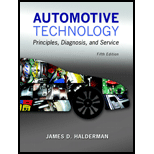
What is the difference between summer-blend and winter-blend gasoline?
Difference between summer-blend and winter-blend gasoline.
Explanation of Solution
Gasoline:
Gasoline is the mixture of various hydrocarbons. Gasoline is refined from the crude petroleum oil. Gasoline is combusted along with air in the cylinder of the engine to produce required power output.
Volatility:
It is one of the properties of the gasoline to become vaporize. Gasoline should be vaporized to mix with air for proper combustion. Thus, the gasoline should possess good volatile property. The pressure and temperature of the atmosphere play a significant role in vaporizations of gasoline. The unit RVP (Reid vapor pressure) measures the volatility of a gasoline. RVP is the pressure of the vapor that is present above the fuel level when temperature of the fuel is 100°F (38°C).
Seasonal blending:
To normalize the pre or post vaporization of gasoline, blending is introduced into gasoline, depending on the seasonal pressure and temperature. It is classified into two types as follows:
- 1. Summer-blending – Do not vaporize at low temperatures.
- 2. Winter-blending - Vaporize at low temperatures.
Both the summer and winter blended gasolines are specially formulated gasolines to achieve proper and complete combustion depending on the season.
Difference between summer and winter blended gasoline:
The significant difference between the summer and winter blended gasoline is volatility. The volatility of summer-blended gasoline should be 7 PSI RVP and the volatility of winter blended gasoline should be 15 PSI RVP. The volatility of summer-blended gasoline should not exceed 10.5 PSI RVP.
Want to see more full solutions like this?
Chapter 66 Solutions
Automotive Technology: Principles, Diagnosis, and Service (5th Edition)
Additional Engineering Textbook Solutions
Statics and Mechanics of Materials (5th Edition)
HEAT+MASS TRANSFER:FUND.+APPL.
Shigley's Mechanical Engineering Design (McGraw-Hill Series in Mechanical Engineering)
Fundamentals Of Thermodynamics
Statics and Mechanics of Materials
Mechanics of Materials, 7th Edition
- As an engines compression ratio increases, what should happen to the octane rating of the gasoline?arrow_forwardHow does a GDI system provide for a stratified charge in the combustion chamber?arrow_forward1-What is specific fuel consumption of an engine? 2-Why does BSFC decrease with load? 3-What happens when petrol is used in diesel engine? Which engine is more efficient? 4-Which engine produces the most torque (diesel or petrol)? Differentiate SFC and TFCarrow_forward
 Automotive Technology: A Systems Approach (MindTa...Mechanical EngineeringISBN:9781133612315Author:Jack Erjavec, Rob ThompsonPublisher:Cengage Learning
Automotive Technology: A Systems Approach (MindTa...Mechanical EngineeringISBN:9781133612315Author:Jack Erjavec, Rob ThompsonPublisher:Cengage Learning Refrigeration and Air Conditioning Technology (Mi...Mechanical EngineeringISBN:9781305578296Author:John Tomczyk, Eugene Silberstein, Bill Whitman, Bill JohnsonPublisher:Cengage Learning
Refrigeration and Air Conditioning Technology (Mi...Mechanical EngineeringISBN:9781305578296Author:John Tomczyk, Eugene Silberstein, Bill Whitman, Bill JohnsonPublisher:Cengage Learning

